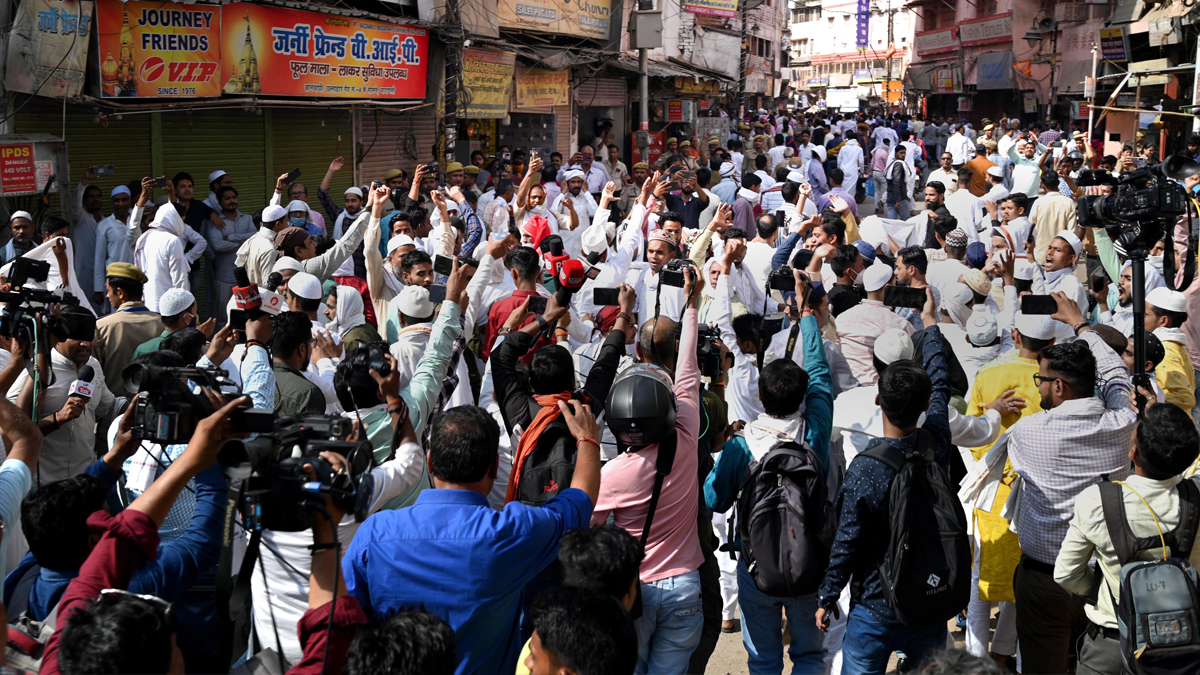Banaras, Uttar Pradesh, India is home to the Gyanvapi Mosque. It was built in 1669 by Aurangzeb after an older Shiva temple was demolished.
A Vishweshwar temple dedicated to the Hindu god Shiva stood on the location. During the reign of Akbar, Todar Mal collaborated with Narayana Bhatta, the patriarch of Banaras’ most famous Brahmin family, to construct it (16th century). In the early seventeenth century, Vir Singh Deo Bundela, a close companion of Jahangir, appears to have restored the temple.
What’s the Big Deal About Varanasi’s Gyanvapi Masjid?
The Gyanvapi Masjid in Varanasi, which is adjacent to the Kashi Vishwanath Mandir, is at the center of a multi-layered legal fight. The Archaeological Survey of India (ASI) has been ordered by a Varanasi court to investigate the building of the Gyanvapi Masjid.

Read More: Taj Mahal Controversy- ASI’s Photos of 22 Underground Rooms Disclose What’s Inside!
However, on Thursday, the Allahabad High Court ordered an interim stay on the Varanasi court’s orders to the ASI. In addition, the Supreme Court is hearing a number of petitions related to the Gyanvapi Masjid-Kashi Vishwanath Mandir conflict.
The Case of Gyanvapi
This is an old case from 1991 when a slew of petitions arrived before the Varanasi court. Local priests had petitioned for permission to worship in the Gyanvapi Masjid region.
The petitioners claimed that the Gyanvapi Masjid was built on orders of Mughal monarch Aurangzeb in the 17th century by removing a portion of the Kashi Vishwanath Mandir.
How Was the Gyanvapi Case Revived?
Vijay Shankar Rastogi, a lawyer from Varanasi, filed a plea in the lower court as the “next friend” of the Kashi Vishwanath Mandir’s presiding deity. In legal language, a “next friend” is someone who represents someone who is unable to represent themselves in court. The Allahabad High Court put the case on hold and suspended the hearing.
A three-decade legal battle over a 300-year old shrine, here's how the controversy of the Gyanvapi mosque unfolded… pic.twitter.com/oMY1UM6akx
— Brut India (@BrutIndia) May 18, 2022
The Gyanvapi lawsuit was reopened in December 2019, a month after the Supreme Court’s decision in the Ayodhya title dispute between the Babri Masjid and the Ram Janmabhoomi.
As a representative of the deity Swayambhu Jyotirling Bhagwan Vishweshwar, petitioner Rastogi requested an archaeological examination of the Gyanvapi Masjid. He stated that the construction of the Gyanvapi Masjid was illegal.
The Varanasi court ordered an assessment of the Gyanvapi Masjid’s structure in April this year after a new hearing of Rastogi’s plea. The Varanasi court ordered the ASI to form a five-member expert team to conduct the study and submit its findings.

Rastogi’s appeal was opposed by the Uttar Pradesh Sunni Central Waqf Board and the Anjuman Intezamia Masjid Committee, which manages the Gyanvapi Masjid. They also fought a court order in Varanasi to survey the Gyanvapi Masjid.
Read More: Old Kentucky Home Controversy- Why ‘my Old Kentucky Home’ Is so Controversial?
The High Court of Allahabad
The case was taken to the Allahabad High Court. The Allahabad High Court on Thursday imposed an interim stay on the instruction to the ASI to undertake the survey after hearing the parties.
The Allahabad High Court’s stay ruling was based on the 1991 Places of Worship Act. The rule bans any modification in a place of worship’s religious character from what it was on August 15, 1947.
The petitioner argued in both the lower and higher courts that the 1991 Act did not apply to the Gyanvapi Masjid because the Kashi Vishwanath Mandir was partially demolished for the mosque’s construction in the 17th century.

The Places of Worship Act arose out of the late 1980s and early 1990s movement for the construction of the Ram Mandir in Ayodhya. In the context of the Babri Masjid-Ram Janmabhoomi title suit, the law made an exception. However, it stated that the law would apply in all other situations.
Why Is There Now a Legal Case?
Even in the Ayodhya judgment, the Supreme Court panel led by then Chief Justice of India (CJI) Ranjan Gogoi referred to the Places of Worship Act.
In its decision, the Supreme Court stated that the Places of Worship Act constituted “legislative intervention” that safeguarded “non-retrogression as an essential aspect of our secular ideals.”
However, in March of this year, a Supreme Court bench led by then-CJI SA Bobde agreed to investigate the law’s constitutionality.
It sent a notice to the central government, requesting a response on the legality of the 1991 Act, which was introduced by the PV Narasimha Rao administration.
After India gained independence in 1947, the legislation effectively stopped all lawsuits seeking to recapture any site of worship.
Why Is the Gyanvapi Dispute Important?
During the campaign for the Ram Mandir building in Ayodhya, the Bharatiya Janata Party (BJP), the Vishwa Hindu Parishad (VHP), and the Rashtriya Swayamsevak Sangh (RSS) evoked the Gyanvapi Masjid issue as one of three sacred sites.

The Shahi Idgah Masjid in Mathura was the third religious site. The Shahi Idgah Masjid, according to the activists, was erected by demolishing a temple near Lord Krishna’s birthplace. A separate petition has been filed in Mathura in order to regain the Katra Keshav Dev Mandir complex, which is the birthplace of Lord Krishna. In February of this year, the Mathura court issued notices to the parties involved.
